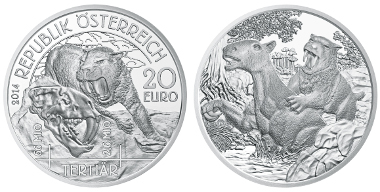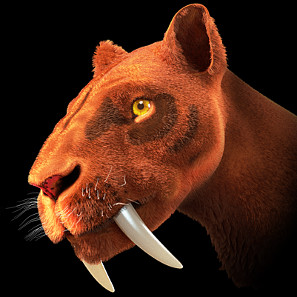September 18, 2014 – On September 10, 2014, the Austrian Mint has issued the fourth coin in its popular “Back from the Dead” dinosaur coin series, accompanied with a new and improved augmented reality app. The first two coins of the series moved from “Life in the Water”, to “Life in the Air”. The third and fourth coins represent “Life on the Ground”.
Austria/ 20 Euro/ Silver .900/ 20 g/ 34 mm/ Design: Helmut Andexlinger/ Mintage: 50,000.
The obverse of the silver coin features the dramatic Sabre Tooth tiger and its powerful canine teeth in a ready-to-pounce pose. The skull detailed on the obverse is also of a Sabre Tooth tiger, its very distinctive teeth clearly noted. The continual timeline along the bottom portion of the coin now depicts a time period from about 30 to 2.6 million years ago. This timeline links all of the coins in this series, from the earliest period to more recent times. The obverse also includes the country of issue, “Republik Oesterreich,” the year of issue 2014 and the face value of 20 euros.
Artistic reconstruction of a sabre tooth tiger. Author: Cicero Moraes/ http://creativecommons.org/licenses/by-sa/3.0/deed.en.
The reverse of the coin shows the power of a Sabre Tooth tiger violently attacking a herbivore known as a Chalicotherium. The Chalicotherium had long claws which enabled it to readily grab vegetation to feed on. The background designs on both sides of the coin depict the swampy landscape of this cooling period when the first glacier formed over the South Pole.
Both sides of the coin were designed by mint engraver, Helmut Andexlinger.
The Tertiary Period marks the beginning of the Cenozoic Era that began about 66 million years ago and continued on to about 2.6 million years ago. This period is a key geological time when a great deal of evolution took place. It was the beginning of the period when mammals replaced reptiles as the main vertebrate on earth. Mountain ranges formed as the continents continued to drift. India bumped into Eurasia to form the Himalayas and Africa drifted into Europe to form the Alps. Plants evolved, and many of which are still found in modern times. Fossils of tree dwelling primates dating to this period, or about some 20 million years ago, have been found in Africa. Humans evolved about 6 million years ago.
Chalicotherium was found in Europe, Asia and Africa. It had long arms in relation to its hind legs. The front arms would dangle and maybe even scrape along the ground as it walked and browsed for its food. The claws allowed it to reach up to high tree branches and pull them down and towards itself. It would chew the food it was grazing on using the large molars located in the back of its jaw. There are no known ancestors of the Chalicotherium. Scientists believe that perhaps its horse-like snout indicates that it may be a distant relative of the present day horse.
An excellent gateway to the world of prehistoric dinosaurs, with a beat-the-clock coin collecting dinosaur game, is the free augmented reality App for smartphones and tablets. Available with this coin series the App provides in-depth background information, as well as bringing the long-extinct dinos back to life with moving images.
Here’s the last issue in the “Back from the Dead” series.
Click here to go the Austrian Mint’s Online Shop.






